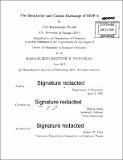| dc.contributor.advisor | Mircea Dincǎ. | en_US |
| dc.contributor.author | Brozek, Carl Kavanaugh | en_US |
| dc.contributor.other | Massachusetts Institute of Technology. Department of Chemistry. | en_US |
| dc.date.accessioned | 2015-09-17T19:14:30Z | |
| dc.date.available | 2015-09-17T19:14:30Z | |
| dc.date.copyright | 2015 | en_US |
| dc.date.issued | 2015 | en_US |
| dc.identifier.uri | http://hdl.handle.net/1721.1/98820 | |
| dc.description | Thesis: Ph. D. in Inorganic Chemistry, Massachusetts Institute of Technology, Department of Chemistry, 2015. | en_US |
| dc.description | Vita. Cataloged from PDF version of thesis. | en_US |
| dc.description | Includes bibliographical references (pages 245-258). | en_US |
| dc.description.abstract | The aim of this thesis is to demonstrate that the inorganic clusters within MOF-5 can be derivatized with redox-active cations for subsequent use in coordination chemistry and small-molecule activation. Rather than reproduce known metal species, this work harnesses the intrinsic properties of the MOF-5 lattice to isolate species that are difficult or impossible to achieve with solution-phase molecules or even other materials. Most of these MOF-5 variants are synthesized through a technique known as cation exchange-a process not well understood. Part 1, chapters 1-6, is devoted to studying the parameters that govern this phenomenon and how they may be manipulated. The first chapter surveys the known examples of cation exchange at the secondary building units of MOFs and poses questions to guide future studies. Chapter 2 reports the isolation of a Ni2+-exchanged variant of this material and demonstrates that this unusual species and changes to its coordination environment can be monitored by conventional methods. Chapter 3 establishes that the original Zn 2+ in MOF-5 also interact with coordinating ligands, but with no more than one Zn 2+ in each cluster interacting at a time. Chapter 4 proposes that this observation explains why only one Zn2+ is replaceable by 0h cations and provides a strategy for replacing the remaining Zn2+ ions. In chapter 5, methods for analyzing crystallographic data are presented for locating and quantifying the occupancy of cations inserted into a MOF. Finally, Chapter 6 describes the solvent dependence of the kinetics and thermodynamics of cation exchange. Part 2, chapters 7-9, describes the reactivity of MOF-5 after replacement with redox-active cations. Chapter 7 provides evidence that the Fe2+ sites in Fe-MOF-5 possess the flexibility and reactivity to interact with N2 . In Chapter 8, Ti3+, V3+, V2+, Cr3+, Cr2+, Mn2+, and Fe2+ variants are shown to undergo electron transfer. Finally, we conclude with evidence that Fe-MOF-5 promotes the disproportionation of NO. Together, these chapters lay the foundation for the eventual goal of heterogeneous catalysis at well-defined metal sites in MOFs. | en_US |
| dc.description.statementofresponsibility | by Carl Kavanaugh Brozek. | en_US |
| dc.format.extent | 263 pages | en_US |
| dc.language.iso | eng | en_US |
| dc.publisher | Massachusetts Institute of Technology | en_US |
| dc.rights | M.I.T. theses are protected by copyright. They may be viewed from this source for any purpose, but reproduction or distribution in any format is prohibited without written permission. See provided URL for inquiries about permission. | en_US |
| dc.rights.uri | http://dspace.mit.edu/handle/1721.1/7582 | en_US |
| dc.subject | Chemistry. | en_US |
| dc.title | The reactivity and cation exchange of MOF-5 | en_US |
| dc.type | Thesis | en_US |
| dc.description.degree | Ph. D. in Inorganic Chemistry | en_US |
| dc.contributor.department | Massachusetts Institute of Technology. Department of Chemistry | |
| dc.identifier.oclc | 921148584 | en_US |
